Devices that could

The previous publication , which told about how the Martian vehicles fell back to Earth, broke in flight, burned in the atmosphere of Mars, or broke on its surface, I want to balance something positive. Therefore, today we will talk about how, overcoming the difficulties already familiar to you, the vehicles still flew to Mars and that they told us of the interesting things.
Prologue
Before the launch of the interplanetary stations, photographs of Mars could only be obtained at ground-based observatories, and the best photograph that could be taken on the equipment at that time looked like this.

Photo of the Mount Wilson Observatory, 1956
')
Yes, it is obvious from this photo that there are no forests and oceans on Mars, but such a clear desire to see life outside the Earth drew the Martian canals, came up with green oases and other ways to survive on an unfriendly planet. Only sending a probe could give much better pictures, and in addition to photographs one could measure the magnetic field, try to determine the pressure and temperature on the surface. Therefore, it is not surprising that both the USSR and the USA began to actively send spacecraft to Mars.
Mariner 4
Briefly: The first device, flying past Mars in working condition. The first photos from a short distance and data about the planet. The photos show a completely lifeless surface.

"Mariner 4" was the seventh unit, which both superpowers tried to send to Mars, and the third, launched in 1964. His fellow Mariner 3 died for a stupid reason, trapped in a non-thrown fairing, but an investigation into this incident allowed the head fairing “Mariner-4” to be fixed. But his flight did not go smoothly. One of the main problems was the constant loss of the Canopus star - the solar sensor gave one axis for orientation in flight from the Mariner, and the Canopus was used for the second axis. After the launch, the big problem was finding the star - the sensor first aimed at the Earth. “Jumping” at the stars, through Alderamin, Regul, Zetu Korma and Gammu Parusov, he was able to get pointed at Canopus, but the star sensor was constantly fixing something that was brighter (most likely, the bright garbage formed during separation from the launch vehicle, flying along the same trajectory), and got off. I had to remotely reprogram the on-board computer so that it would not start to twist the device when the flash of debris turned out to be brighter than the star, restarting the search algorithm. Even a maneuver to correct the trajectory after more than seven months after the start took place later due to another loss of Canopus with a star sensor.
On July 15, 1965, Mariner 4 flew past Mars and took 21 photographs. Tension reached its peak. Could refuse equipment - the recorder on the "Mariner" was a spare, and the camera could easily break from a long flight. Yes, and to see the Martians was unbearable. Therefore, the staff of the Jet Propulsion Laboratory ran for pencils and began to manually color the digital color values of the pixels sent by the station.

However, computers, albeit more slowly, but reproduced a more accurate picture.
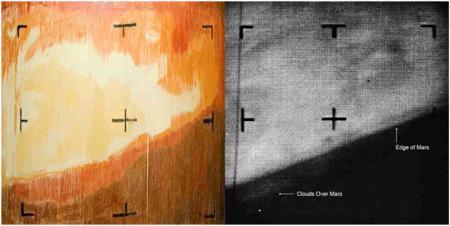
“Mariner” transmitted 634 kilobytes of data from the vicinity of Mars (who said that 640 kilobytes would be enough for everyone?), And the results were extremely depressing for supporters of the idea of life on Mars. The photographs had a dead surface with craters, like on the Moon, the pressure was estimated at 4-7 millibar (0.5-1% of the earth, as it turned out later, right), and the temperature at -100 ° C (-143 ° C - +35 ° C according to modern data).
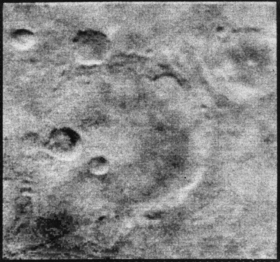
Due to the fact that the camera carried red and green light filters, areas of paired images could be obtained in color.

It is now we know that by chance "Mariner" flew past the most interesting sections of Mars. But it was “Mariner 4” that, in a sense, drew the line of Martians in science fiction - after such photographs, reasonable aliens already wanted to be thought up somewhere far away.
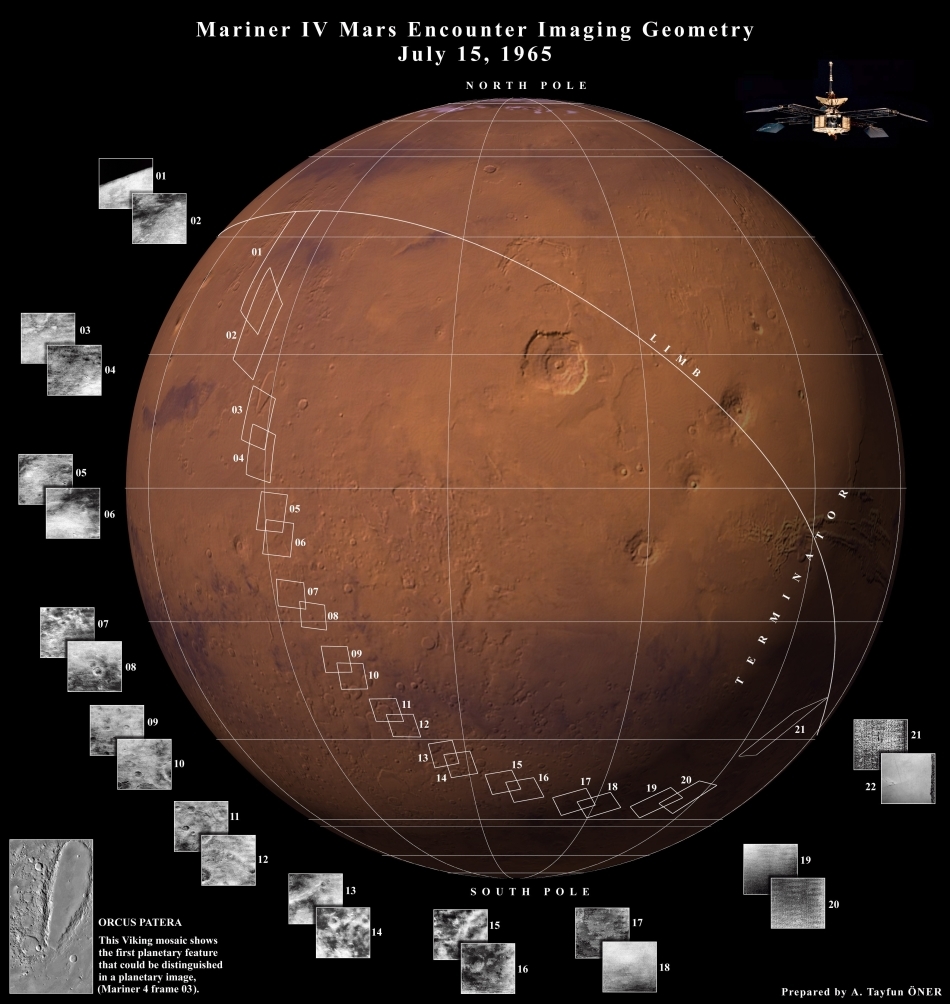
Large image on the link
Mariner 6 and 7
Briefly: Two identical apparatus. Photographed 20% of the surface.

In the spring of 1969, 4 vehicles launched to Mars. Two Soviet did not even go into Earth orbit, and both American successfully went to Mars under the names "Mariner" -6 and -7. At the end of July 1969, both vehicles flew past Mars and took a series of photographs each.

In total, about 20% of the surface was photographed, but, funnyly, again missed the giant canyon and volcanoes of the province of Farsis. Again no channel signs were detected.
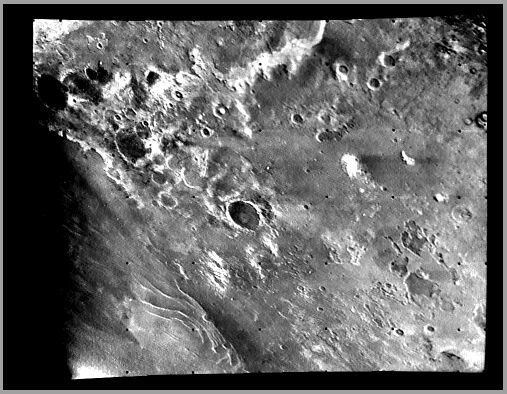
The amount of data even allowed us to build a globe of Mars, but in general it was clear that flying missions are ineffective, and we must go into orbit. Only in the orbit of Mars can be long and shoot all the new photos of different places.
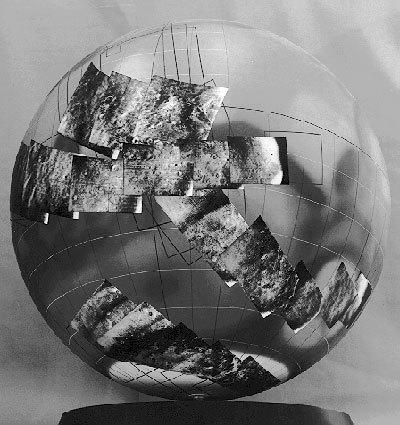
Ironically, the passage of Mars took place in the shadow of the successful landing of the Apollo 11, and received much less attention than it deserved.
Mariner 9
Briefly: The first apparatus to go into orbit. Photos in much better quality. 85% of Mars is filmed. Traces of liquid water are found in the past.

In 1971, as many as five vehicles went to Mars. One Soviet and one American did not go farther than Earth’s orbit, but among the three remaining (2 Soviet (+ 2 landing) and 1 American) an exciting competition ensued - who will fly first and gather more information. It so happened that Mariner 9 won in him. The fact that he first went into orbit on November 14 was, perhaps, propaganda meaning - “Marsses” -2 and -3 arrived in less than a month. But all three vehicles encountered an unexpected problem — a dust storm was raging on Mars, and it was useless to remove from orbit.
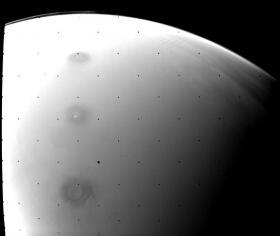
Only the highest volcanoes of the province of Farsida are visible above the dust.
And here the strengths of the American probe were revealed - the flexibility of the mission and a long time of existence. The program for photographing was postponed, and the probe could not break before the storm calmed down. In January 1972, excellent pictures with an order of magnitude higher resolution were already sent (98 meters per pixel against 780 meters earlier).

Mars North Pole

Labyrinth of the Night
But the main sensation was the traces of erosion, from which it followed that once there could be water on Mars.

In memory of the success of this apparatus, a huge canyon on the planet was called the Mariner Valley.

A more modern photo of the Mariner Valley, Night Maze on the left
Mariner-9 is still in Mars orbit, but the archaeologists will not wait for the future; it is expected that it will burn in the atmosphere around 2022.
"Marsses" -2 and -3
Briefly: Some photos, temperature and pressure measurements on the surface, measurements of the water vapor content in the atmosphere.

If the program of these vehicles would have been completely completed, then half of Mars could be called in their honor. Devices consisting of orbital and landing modules could map the planet and receive data from its surface. But, alas, despite the successful landing of the Mars-3, we did not receive useful data from the surface. And the orbiters did not have such flexibility as the Mariner 9, and spent a lot of film wasted on photographing a dust storm.

The availability of photographs is also, alas, much lower. In Soviet times, an album was published with processed images of various missions, but on the web now you can only find a couple of photos.
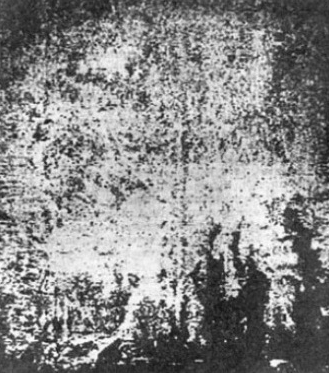
Mountains in the equatorial region

Composite (collected from images with different color filters) image
The Marsov equipment was similar to the scientific instruments of the Mariner-9, but was somewhat different. Working at the same time, all three devices obtained scientific results about the planet, among which, however, no sensations were found. Water vapor is 5000 times smaller than on Earth, sometimes there are clouds, cold, uncomfortable, and no noticeable life.
"Mars" -4, -5, -6, -7
Briefly: The best photos for the USSR, data on the atmosphere and surface.
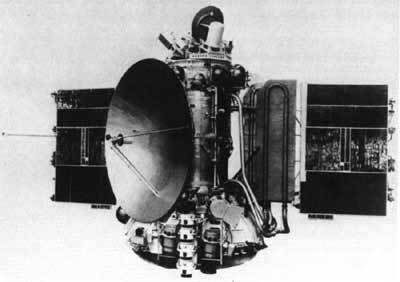
In 1973, only Soviet vehicles flew to Mars, but as many as 4 pieces - two orbital and two landing with their own migratory steps. From the landing gears, we received only partial information about the composition of the atmosphere during the descent of Mars-6, but Marsy-4 and -5 were able to partially execute the program from orbit. "Mars-4" could not slow down, so he removed only a strip of the surface.
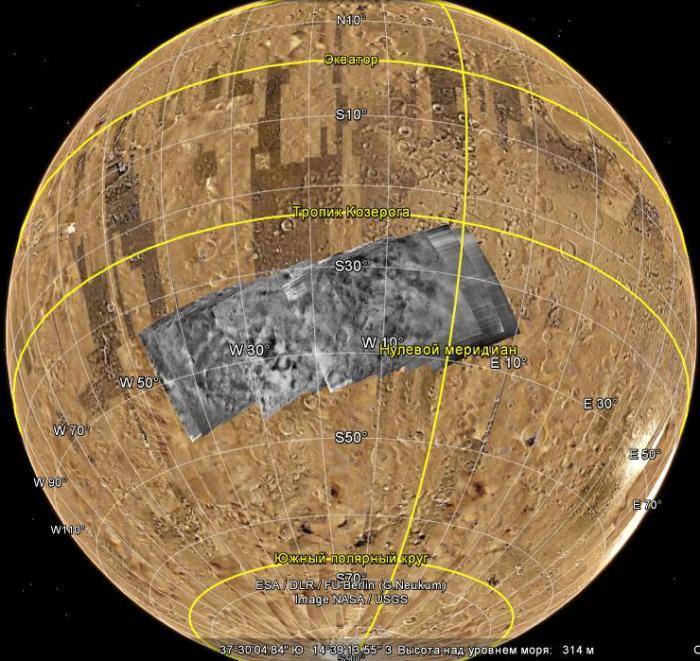
And "Mars-5" went into orbit, but immediately began to lose the atmosphere from the sealed instrument compartment. For 9 days, MCC managed to get 108 frames, of which 43 were of acceptable quality.

Panorama

Composite image
Viking -1 and -2
Briefly: The first long-running landing stations, a huge amount of data, two big puzzles.
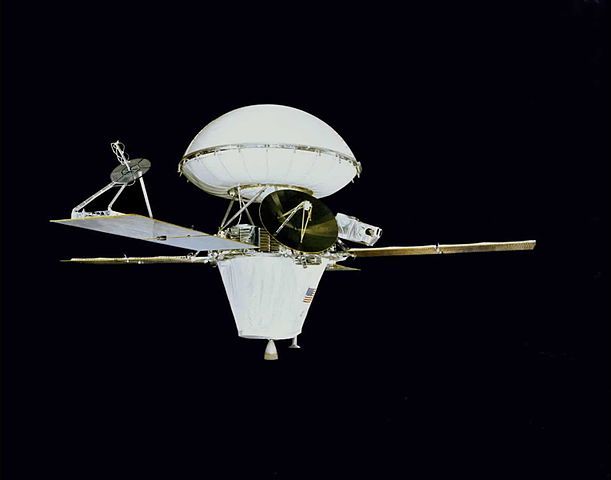
The 1973 pass was more than compensated by the Americans in 1975 by sending two Viking stations, each of which was an orbital probe and a landing module. Not a single device was lost, on the contrary, they all worked much longer than planned, and transferred huge amounts of data.
The orbiters worked for two and four years, and, thanks to technical progress, pleased us with much better photos.

Mosaic on the photo of the Viking-1 orbiter
More traces of water were found.
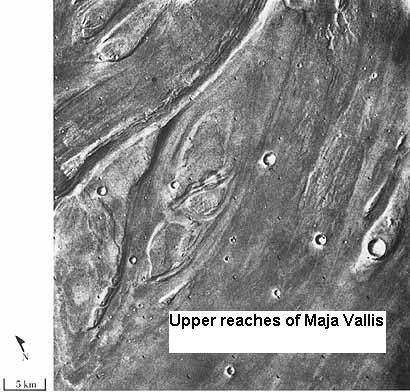
And also opened a new type of relief - "chaos". In these places, presumably, huge volumes of water came to the surface.

Chaos on the right
And, of course, we are obliged to the Viking-1 orbiter the photo "Persons on Mars".
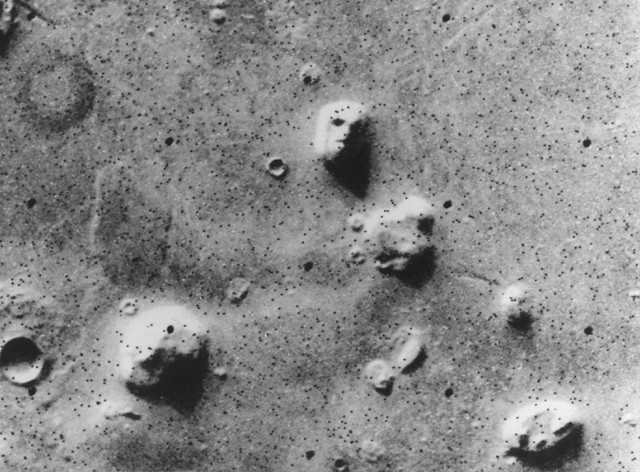
The landing modules successfully sat down and worked for more than four and more than six years, transmitting photographs, panoramas and working weather stations.

Panorama. Large photo 8000 pixels wide

Winter at the landing site. Carbon dioxide fell. Great photo 3000 pixels wide
But the main task of the landing gear was the search for life. And here the results turned out to be contradictory - according to the behavior of the samples, it was impossible to say whether it was life or whether there was something in the composition of the soil that was not taken into account when planning the experiments. In general, after the "Mariner 4" "Vikings" rocked the pendulum in the opposite direction - if you wish, you could even believe in intelligent life on Mars. Someone built a pyramid and a face in Cydonia?
"Phobos" -1 and -2
Briefly: New data on Mars and Phobos.
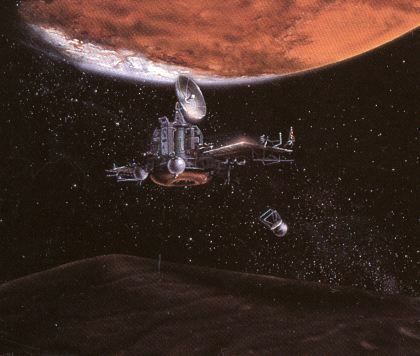
However, the data of the "Vikings" rather only marginalized. The scientific mainstream has cooled down to Mars, and as many as 13 years no stations have been sent there. Yes, and "Phobos" in 1988, had the main goal is not Mars, but his satellite. Despite the fact that the program was not fully implemented, photographs of Mars were obtained and, in good quality, Phobos, as well as various data on the plasma environment of Mars, the temperature of Mars and Phobos, and the rate of atmospheric loss was estimated.
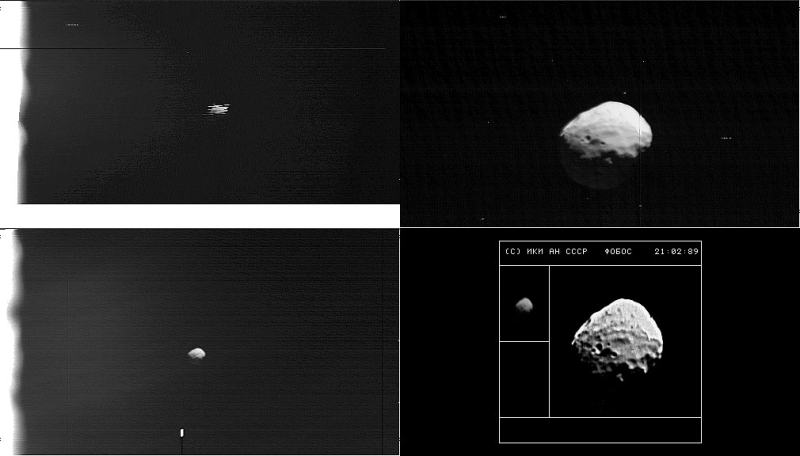
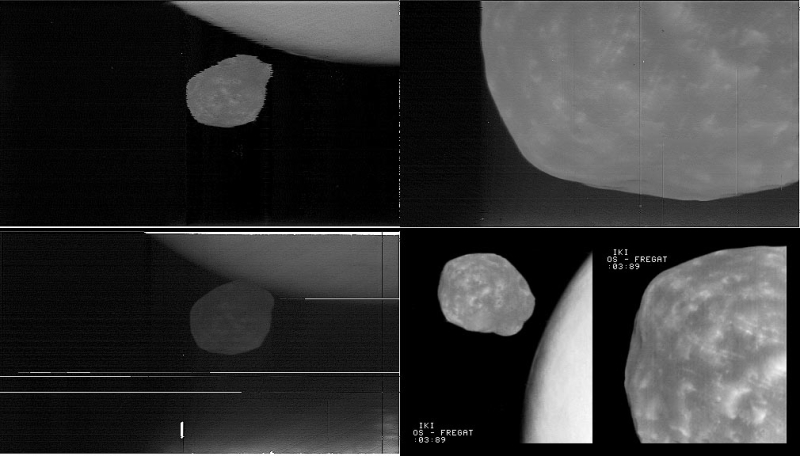
Mars Global Surveyor
Briefly : Mapping at the new level of technology. Photos showing the presence of liquid water.

Mars Global Surveyor, which set off to Mars in 1996, was supposed to map Mars on a new level of technology, which from the cameras of the Vikings of the 1970s made serious strides, and also served as a repeater for future missions. The probe entered solar-synchronous orbit and flew over the surface when it was always 14 o'clock local time. Stable lighting conditions made it possible to create a very good map. The photos, depending on the task, could have a resolution of 1.5-12 m per pixel in high resolution mode, 240 m / pixel in context mode, and 7.5 km / pixel in daily viewing mode. During the nine years of operation, the probe transmitted more than 240 thousand photos.
The creeps found on the slopes were very curious. They were difficult to explain without attracting liquid water. But at temperature and pressure, as on Mars, water cannot be liquid. However, there is a fairly simple explanation. The next time you get angry at public utilities who sprinkled salt on snow or some other nasty thing, you better think that you see a little Martian process - salt water freezes at a lower temperature and can flow down the slopes of Mars. And if we assume that the salt is perchlorate, then the ambiguity of the search results for life by “Vikings” can be explained.

Well, since the size of the "face" on Mars was about 1.5 km, they were able to photograph it in high resolution. Alas, instead of the Martians, we found our own brain imperfection - paradydia. It is evolutionally advantageous to be in vain to be frightened to see the illusion of a person preparing to attack you in the bushes, than not to notice the criminal who is actually sitting there, therefore there are examples of such errors, I think, in the memory of everyone.
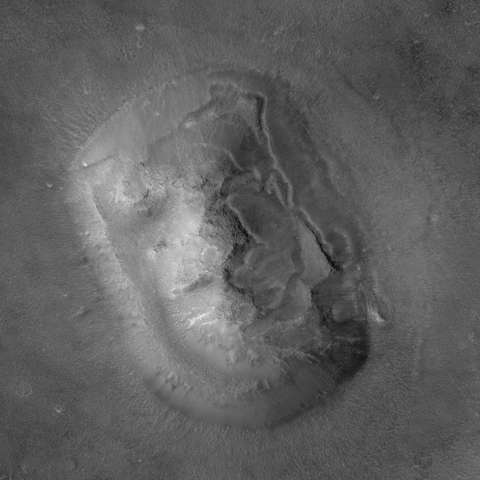
Mars Pathfinder & Sojourner
Briefly: The first surface rover, new data, test technologies.
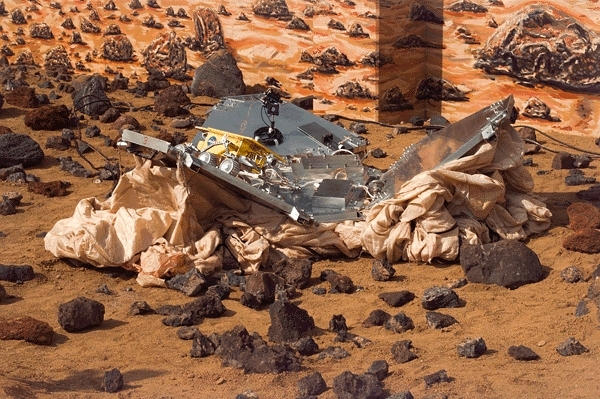
Twenty years have passed since the Vikings, and the task of landing a long-term station on Mars has again become interesting. The technology also made it possible to create a small but relatively autonomous rover, and for landing heavier rovers it would be good to practice. Therefore, in 1996, Mars Pathfinder landing gear went to Mars with a small Sojourner rover. The station successfully landed on Mars and worked for almost three months instead of from a week to a month according to plan, collecting 2.3 gigabits of information.

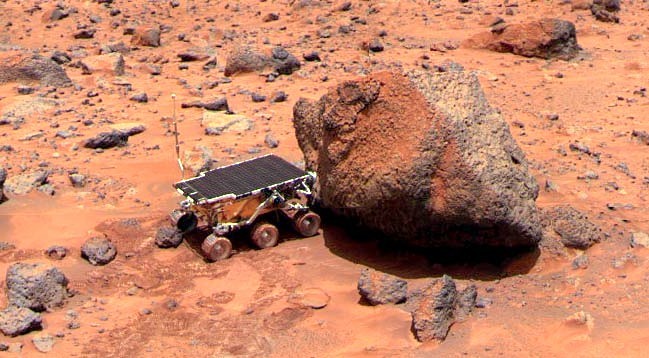
Mars odyssey
Briefly: Measurements of water ice content under the surface and radiation environment, as well as geological data. Works as a repeater.

What is the name of the device that will fly in 2001? Of course, Odyssey, because so many people read Clark's Cosmic Odyssey. But the idea was not accepted immediately - such a name could cause problems with copyright and trademarks. Fortunately, Arthur Clark was still alive, and he liked the idea very much. And the device itself successfully entered the orbit of Mars and is still working, setting a record for longevity among the probes rotating in the orbit of other planets. As for scientific results, the Russian-made neutron detector found hydrogen in large quantities, indicating that there should be ice under the red surface. Mars Odissey will have enough fuel to maintain orbit until the mid-20s.
Mars express
Briefly: The first European apparatus in orbit, cartography in different ranges, radar sounding.

Mars Express is now loved to be compared with the ExoMars - the Russian rocket, the success of the orbiter and the landing gear’s failure, have them in common. Structurally similar to the "Rosetta" and the Venus Express, the probe is the only remaining device on this chassis. The device also found evidence of water, and also collected a lot of data.
Spirit and Opportunity
Briefly: Two rovers collected a lot of geological data.
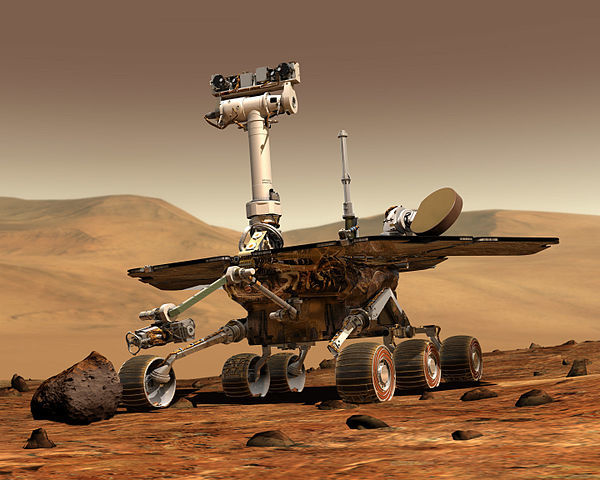
After the Mars Pathfinder tests, NASA decided that it would be able to land a new type of Martian research vehicle - a long-term, autonomous and rover-capable rover. But, just in case, sent it in duplicate. Fortunately, they both sat down and got to work, and Opportunity is still alive. On orders of magnitude exceeding the planned periods of existence, the rovers have collected a lot of information about the geology, atmosphere and other characteristics of Mars. And, of course, made a lot of beautiful photos.

Crater Bonneville, photo Spirit, it is also in high resolution

Dust eddies are the same on Earth
Mars Reconnaissance Orbiter
In short: The most powerful camera in Mars orbit.
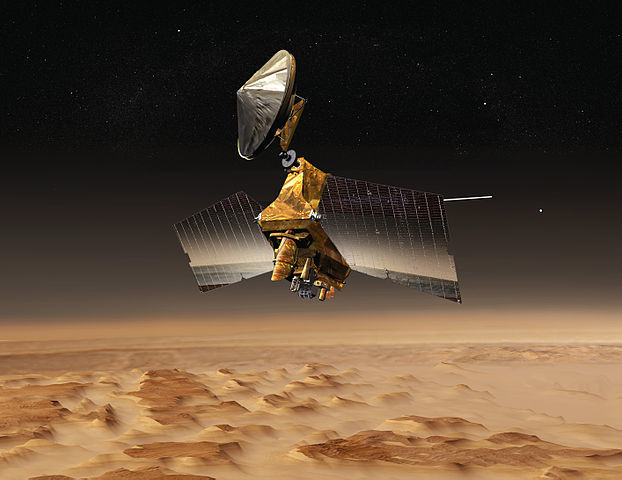
Launched in 2005, the MRO has been operating for 11 years and takes pictures no longer gigabytes, but terabytes, since the maximum resolution of 0.3 meters per pixel allows you to see the surface better than all other devices. MRO saw a lot of ice and snow, gas geysers, avalanches and even other Martian vehicles on the surface.

Avalanches
Phoenix
Summary: Confirmation of the presence of water ice below the surface.
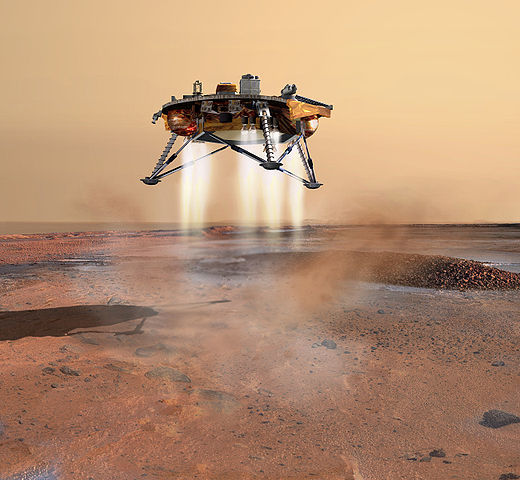
The main task of "Phoenix" was to sit near the pole, open the bucket, dig the surface and see what happens. Because remote observations said that there is ice, but they could not definitely prove it. The device successfully sat down in May 2008 and completed the task.

After holding out until the onset of a cold winter of 161 days, the device was able to collect data on climate and surface. And he photographed the clouds.

Now
New data from the Martian missions are moving from the qualitative to the quantitative plane. More photos, geology and other data. Now, besides the Mars Odyssey, Mars Express, Opportunity and MRO mentioned above, laser-atomic Curiosity (even more geology) is working on the surface of Mars, and the Indian Mars Orbiter Mission (a great success of the Indians), MAVEN (managed to find that the atmosphere of Mars blew off the solar wind) and just set to work “ExoMars” (will search for life, analyzing the atmosphere and determining the origin of methane in it). Perhaps the detection of life can be a sensation, but I think (if it is found), as well as with water, it will be a long process - one experiment can notice traces, then put on some more experiments on different devices and only then declare that they have found local bacteria that are not exactly brought with them. If Mars is completely dead, then this life will be sought for decades. However, in order not to be bored, we will have terabytes of beautiful photos.
Source: https://habr.com/ru/post/398863/
All Articles